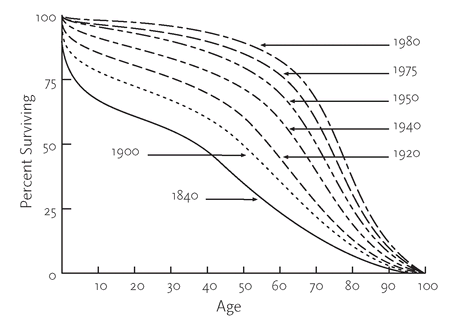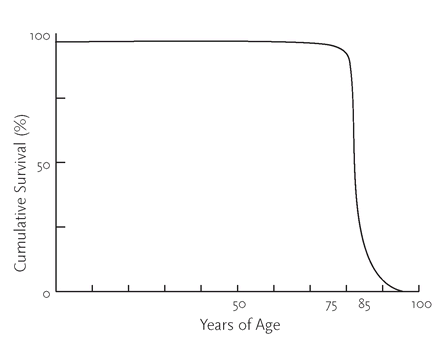12
Brave New World
HEALTH CARE, to put it mildly, is an industry out of control. If we don’t make some major changes, projections show that by the year 2014, spending on health will account for nearly one-fifth of America’s gross domestic product.
1 By the middle of this century, spending on Medicare alone will consume an estimated 40 percent of the U.S. budget. This is unsustainable, and its effects are already showing up in a variety of painful ways.
Even as I write, General Motors—once the biggest, most powerful corporation in the entire world—is announcing draconian plant closings and workforce cuts that will eliminate more than 30,000 jobs in North America over the next few years. The main reason is the cost of health care for GM’s current and retired workers, which is now so high that it adds $1,500 to the price of every vehicle the company manufactures. And General Motors is hardly alone. Star-bucks, one of the most successful companies of the past two decades, recently announced that it is spending more on health care for employees than it spends on coffee beans.
Across the American economic spectrum, employers are trying desperately to rein in health costs, asking workers to pick up more of the tab for their care or, in many cases, dropping insurance coverage entirely. Labor unions are discovering that they cannot negotiate contracts that keep wages apace with inflation because the cost of health care is severely eroding corporate profit margins. Companies are closing down factories and jobs at home and relocating them overseas, where wages and health costs are much lower. All the while, increasing numbers of American workers are sliding into the ranks of the uninsured.
What can we do? I have a fairly radical answer for that question: We should aim at eliminating chronic illness. That is not an unattainable goal.
Most of America’s health dollars are spent on the late stages of heart disease, strokes, hypertension, diabetes, and the common Western cancers of the breast, the prostate, and the colon. Like heart disease itself, these others are part of the bitter harvest of the toxic American diet. And like traditional treatments for heart disease, their treatment is not preventive. Having your breast cancer amputated, your malignant prostate gland radically removed, or your cancerous colon resected is painful, disfiguring, and costly—and too often does not resolve the underlying problem.
My own research has concentrated on coronary artery disease, and how plant-based nutrition can prevent and also arrest and reverse it. But with every year that passes, there is more proof that a plant-based diet has similar salutary effects on other chronic diseases, as well.
Take stroke, for example—the third leading cause of death in the United States. The evidence is overwhelming that if you eat to save yourself from heart disease, you eat to save yourself from stroke.
There are two types of stroke. In hemorrhagic stroke, the less common of the two, a blood vessel in the brain ruptures because of high blood pressure or a genetic weakness of the vessel wall known as an aneurysm. A plant-based diet cannot do anything to cure a genetic aneurysm. But it will definitely help reduce blood pressure, an important step in the right direction.
On the more common variety of stroke—ischemic or embolic stroke—there is even better news. These have the same origin as coronary artery disease. An ischemic stroke occurs when fat and cholesterol block blood vessels that carry oxygen and nutrients to the brain, just as they may block the coronary arteries that nourish the heart. An embolic stroke also deprives the brain of nutrients and oxygen, but in a slightly different way. When an artery sheds part of its diseased inner lining, that debris—called an embolus—is carried through the bloodstream until it gets wedged into a blood vessel that is too small for it to traverse. Now it blocks the flow of blood through that vessel. This may happen almost anywhere in the body, blocking blood flow to a kidney, an intestine, a leg, or some other organ. When it occurs in vessels that nourish the brain, it is a stroke.
In the 1990s, Pierre Aramenco, a physician from Paris, studied this process in Frenchmen who were at risk for vascular disease.
2 Using ultrasound probes inserted through the esophagus, Dr. Aramenco measured the thickness of atherosclerotic debris growing on the inside of each patient’s ascending aorta, the giant artery that climbs directly from the heart and sends branches to the brain. He divided the men into three groups. One group showed 1 millimeter of debris on the lining of the aortic wall. The second had debris measuring between 1 and 3.9 millimeters thick. The third had more than 3.9 millimeters of debris. Dr. Aramenco followed the patients for three years. Not surprisingly, the group with the greatest amount of plaque growth shed the greatest number of emboli, and had the most strokes (see
Figure 17).
The buildup of fatty plaques in blood vessels can cause damage in many different ways. For example, when an aorta that contains plaque is clamped during coronary bypass surgery, plaque debris is loosened and enters the bloodstream as an embolus. Using ultrasound to monitor the middle cerebral artery in the brain, technicians can distinctly hear the embolizing plaque as it enters the brain. If the patient dies during surgery, the plaque debris may be found in the brain at autopsy.
This tragic sequence helps explain the fearful loss of cognition in coronary artery bypass patients.
3 But neuroradiologists also report that using magnetic resonance imaging, they can detect little white spots in the brains of Americans starting at about age fifty. These spots represent small, asymptomatic strokes (see Figures
18 and
19). The brain has so much reserve capacity that at first these tiny strokes cause no trouble. But, if they continue, they begin to cause memory loss and, ultimately, crippling dementia. In fact, one recently reported study found that the presence of these “silent brain infarcts” more than doubles the risk of dementia.
4We now believe, in fact, that at least half of all senile mental impairment is caused by vascular injury to the brain. Not long ago, a Swedish study of five hundred eighty-five-year-olds found that fully one-third of them showed some form of dementia. A careful analysis revealed that in half of those with dementia, their mental impairment was due to a diseased arterial blood supply to the brain.
5 Similarly, a study in the Netherlands focused on five thousand people between the ages of fifty-five and ninety-four.
6 The researchers studied the circulation in the brains of all their subjects, then asked them to perform various written tests of mental acuity. The results were quite clear: those suffering from artery disease and thus impaired circulation in the brain performed less well on the tests than did those whose arteries were clean. Age made no difference. Arterial health was the variable that counted.
This should come as no surprise. Clogged arteries serving the brain and clogged arteries serving the heart are part and parcel of the same disease. The cause is the same: a buildup of fat and cholesterol and lethal damage to the delicate endothelial lining of the blood vessels. And the cure is the same, as well: adopting a healthful new way of eating that includes not a single ingredient known to damage vascular health.
Just as you are not doomed to heart disease as you grow older, you also are not doomed to mental deterioration. Most cases of stroke and dementia, like heart disease, need never occur. Your aorta, along with all your other arteries, can be as clean at ninety years of age as they were when you were nine.
Two of my original heart patients had strokes before joining my nutrition program. William Morris had just one stroke. Emil Huffgard had three. As a result, both had suffered impairment of their walking. More than twenty years later, both of these men are alive and well. Neither has had any further strokes. The same plant-based nutrition that saved their hearts also saved their brains.
I have mentioned previously that several of my patients have also noted a distinct improvement in their sex lives. And recent research confirms a strong connection between impotence and cardiovascular disease. In December 2005, researchers reported on a study that followed 3,816 men with erectile dysfunction and 4,247 without over seven years.
7 It turned out that the men who were impotent before the study began or who developed it during the study were 45 percent more likely to experience a cardiovascular event than those free of erectile dysfunction. Impotence, it turns out, is as robust a predictor of cardiovascular disease as elevated cholesterol, smoking, or a strong family history of the disease. Our own anecdotal evidence suggests that profound lifestyle change with plant-based nutrition offers the optimal opportunity to avoid heart disease—and to restore erectile capacity.

Figure 20. Survival curves, 1840-1980, reveal that our life expectancy has greatly increased but our life span has remain unchanged. (Reprinted with permission from Vitality and Aging: Implications of the Rectangular Curve.)
Figure 21. If we are to shift the survival curve significantly to the right, for a rectangular survival curve, we need to overcome chronic diseases. (Reprinted with permission from Vitality and Aging: Implications of the Rectangular Curve.)
With every passing year, we understand more about the mechanisms through which nutrition affects our health, and virtually everything we are learning underscores the benefits of abandoning the high-fat habits of old in favor of a plant-based diet that fills our plates and our selves with a most nutritious array of disease-preventing, injury-healing, health-enhancing ingredients.
If you were to chart the course of most people’s lives in the modern West—as explicated by Dr. James Fries and Dr. Lawrence Crapo in a book entitled
Vitality and Aging8—the graphic would show steady health toward the prime of life, a period on that prime plateau when all was well, then a long, steady decline toward death (see Figure 20). I believe that we can change that profile dramatically. The new graphic would show the same steadiness in the prime, but the plateau—that period of health, strength, and well-being that marked the middle section of the old graphic—would be extended. No longer would chronic illness precipitate the sad decline of later years. Instead, all would be well until, naturally, all systems eventually shut down (see Figure 21).
All that, simply by learning to eat well.


